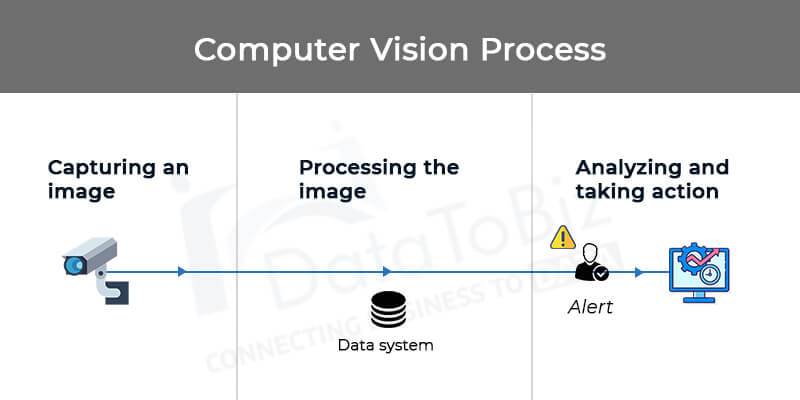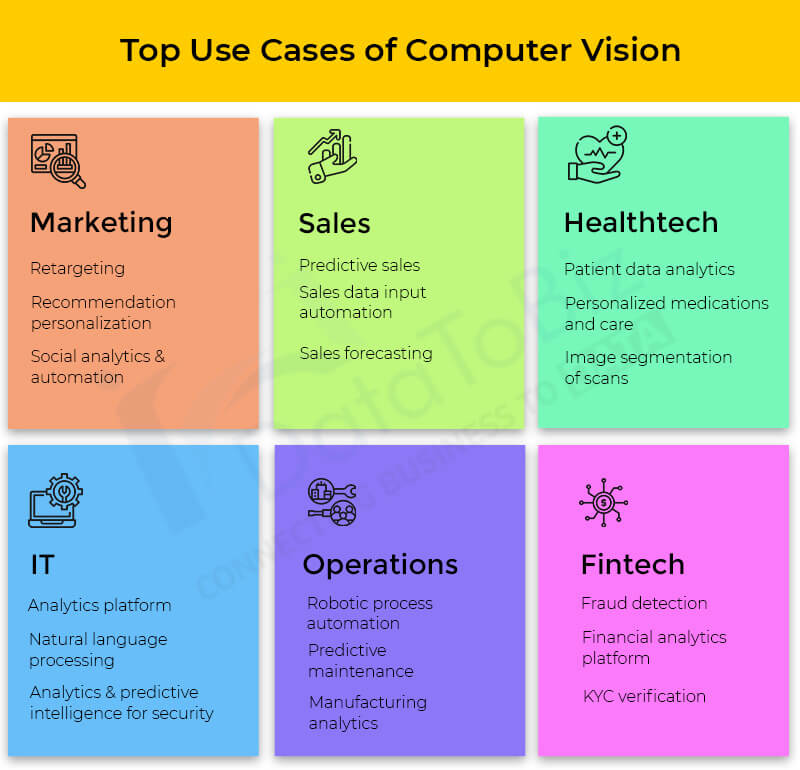As humans, we can easily see, process, and act on something that could be considered a visual input. But how can that be replicated in machines? That is precisely what computer vision aims to do. While there may be limitations for a machine to act like humans, they are quite close when it comes to analyzing and acting as programmed to do.
To cut it short, Computer Vision can be described as a process when a computer using artificial intelligence is able to identify and process visuals (like photos and videos), extract insights from them to create an appropriate output that makes the process of decision making simpler. According to this market analysis report conducted in 2020, the global computer vision market size was at a value of USD 10.6 billion in 2019 and is expected to grow at a compound annual growth rate (CAGR) of 7.6% from 2020 to 2027.
Before going into the computer vision techniques that you can implement for your business, let us understand the basics.
Computer Vision is enabled with the capability to read, identify, classify and verify objects. The recent developments were facilitated by ML or Machine Learning technology, especially the process that requires iterative learning, and significant updates in computing power, data storage, and high-quality yet inexpensive input devices. Before we look at how firms are making use of this technology through in-house computer vision services or by outsourcing it to an expert computer vision consulting firm, we need to understand what goes into making this technology so different.

When a digital device like a camera or CCTV captures an image, it is basically creating a digital file consisting of zeros and ones in the computer’s language.
Algorithms are used to determine basic geometric elements to create images out of the acquired binary data.
The final component that makes the process of computer vision application successful is the analysis of the data. The system then acts according to the way it is programmed and notifies the administrator or manager.
A part of computer vision applies machine learning, and they are both spin-offs from AI. However, computer vision involves tasks like image identification and classification, object detection and tracking which is way different from what ML does.
A number of industries have been using Computer Vision to enhance customer experience, reduce costs and increase security. Some of the major players are retail, manufacturing, surveillance, and weather forecast.
Recent developments in neural networks are deep learning initiatives that have greatly advanced the way these visual recognition systems perform. And while it’s easy to learn about the basics of computer vision, implementing it in the right way irrespective of the industry a business belongs to, is difficult. In such a situation computer vision consulting services seem like the best go-to option to implement this technology. And the top features of the technology that these firms make use of in their decision-making strategies are as follows-
The fact that a computer system can identify, analyze, and act almost like a human sounds great. But for that to happen, the visuals that the input device captures must be classified into a particular category to take action. There are a good number of challenges associated with image classification in computer vision like viewpoint variation, scale variation, intra-class variation, image deformation, image occlusions, illumination conditions, and background clutter.
To overcome these challenges, computer vision researchers have derived a data-driven approach to solve this. Instead of trying to specify what one type of image category looks like directly in code, they provide the computer with examples of each image class. Learning algorithms are then developed for the computer to learn about the visual appearance of each class so they can go with the classification easily.
The task to define objects within images involves placing bounding boxes and labels for individual objects. This differs from image recognition and classification in a way that detection would put objects in a particular box after the image classification has been done. Say for example, if there are multiple cars in an image, all cars need to be detected and put in a bounding box. For classification though, there are just two ways to do it- object bounding or non-object bounding.
Object detection is important as it helps the system to understand the image or video and prepare for analysis. The major difference between image recognition and object detection is that the latter has the ability to locate objects within an image or other input visual. This can be applied in a number of ways by businesses or retail stores that implement professional computer vision services for crowd managing, self-driven cars, anomaly detection, face detection, and video surveillance.
Object tracking involves estimating the state of the target object present in the scene from the information collected. The process involves two levels. First known as Single Object Tracking where the appearance of the target is tracked. And second, MOT or Multiple Object Tracking where a detection step is necessary to identify the targets that can leave or enter the scene.
A major challenge in tracking multiple targets originates from the various interactions between objects that can sometimes also have a similar appearance. In recent years, due to the exponential rise in the research of deep learning methods, there has been a tremendous rise in the accuracy and performance of the detection and tracking approaches.
We are all aware that an image is nothing but a collection of pixels. Image segmentation can be considered as a process of classifying each pixel in an image to a certain category. However, semantic segmentation does not differentiate between different instances of the same object. For example, if there are two cats in the same image, semantic segmentation will put them under the same label of both cats. Few more use-cases of semantic segmentation include-
A level beyond semantic segmentation, Instance segmentation segregates different types of the same object into different categories. For example, if there are five cars in different colors, Instance segmentation will label them accordingly. However, as easy as it might seem to us, segmentation is not an easy task, especially when talking about instance segmentation as it needs to analyze the difference in objects in a visual with multiple overlapping objects and different backgrounds.
The CNN or Convolutional Neural Networks can be effectively used in many ways. One of them includes locating the exact pixels of each object instead of just the bounding boxes. An example of where Instance Segmentation has been used is the Facebook AI where the application or desktop version of the product can differentiate between two colors of the same object. The architecture implemented here is an extended version of CNN known as the Mask R-CNN.
Computer vision is getting rapidly adopted by companies in various industries owing to the competitive advantage it serves. The potential to accurately solve problems without the need for human intervention, especially in recent years, is one of the primary reasons for this rapid growth. Let’s take a look at the versatility this technology offers in different industries.

One of the most inexplicable applications of computer vision in the automotive industry is by Tesla. The autopilot mode of a vehicle was launched with a driver-assistance system back in 2014 itself but only with a few features. With iterations and further developments on validation and test algorithms, fully self-driven cars were finally launched in 2018.
Computer Vision when coupled with sensors can do wonders for critical manufacturing equipment. This technology is used to check on important manufacturing plants where infrastructure faults are quite common. A good number of manufacturing firms are implementing predictive maintenance in their process to keep their tools in good shape. One example is where a camera is attached to a robot that captures the image. This data is then processed to provide diagnosis and detect any threats in the manufacturing process.
Computer vision is considered quite a boon for the retail industry.
Walmart is using vision analytics, an application of computer vision, to track theft at checkout counters. The program uses a camera to detect scan errors and failures in very little time. As soon as an error is detected, the vision analytics system notifies the manager or store in-charge immediately, so the required action can be taken. Not only does this reduce in-store theft, but also reduces events of fraudulence and prevents any loss. The retail industry is making wide use of machine vision consulting services to implement the latest technology for anomaly detection in stores.
In the healthcare industry, computer vision has proved to be not a luxury but a necessity in the year that went by. Yes, computers cannot replace humans but they can definitely be used to aid healthcare personnel by easily handling the enormous amount of data produced by patients every day. Microsoft recently launched its InnerEye project that uses AI to analyze three-dimensional scans like an X-ray or Ultrasound. The technology is said to have the ability to process 40 times quicker, while also suggesting the most effective treatments.
Computer vision is used to enable security at public places like parking lots, railway stations, highways, and so on. Be it face recognition, crowd detection, or human abnormal behaviors detection, this technology can notify the person in charge and prevent any sort of mishaps on the road.
Computers are used to sort and analyze millions of images that a human eye could probably miss. It is also understood that marketers who are aware of demographic research and look forward to target marketing use computer vision to ensure ads are not placed anywhere close to any content that could contradict its use.
The main benefit of using computer vision is the accuracy with which it works and can limit the need for human intervention wherever necessary. And while this whole process is splendid, firms make use of individual features like image recognition, object detection, or instance segmentation depending on their use to aid decision making.
Today various applications of computer vision are being used across industries to enhance the consumer experience, reduce costs and increase security. This has led to a surge in demand for computer vision engineers and computer vision consulting firms. While engineers can help build the application for a particular firm, computer vision consultants or firms work around the whole process of product development, right from identifying the need to implementing the technology at the right step.
Even though computer vision algorithms continue to face challenges with respect to image clarity and training datasets, what cannot be ignored is that the factors it can omit for us on a daily basis, like reduced manmade errors, time-saving, and reduced cost of wastage.
You must be logged in to post a comment.

As per my view computer vision is one of the most important AI technology which is used so extensively. Most importantly it is used in Surveillance system.